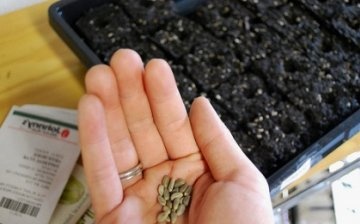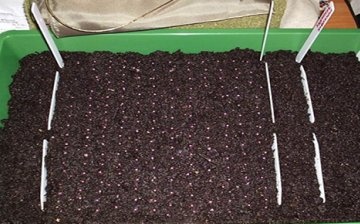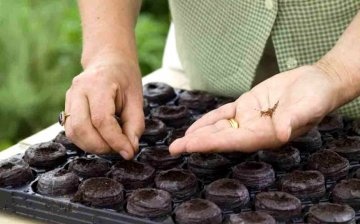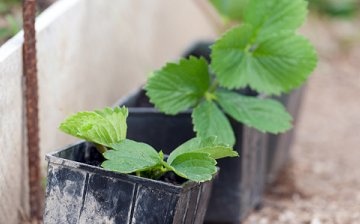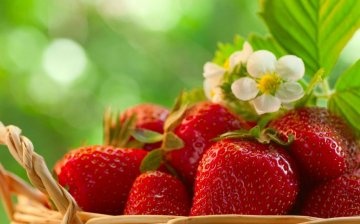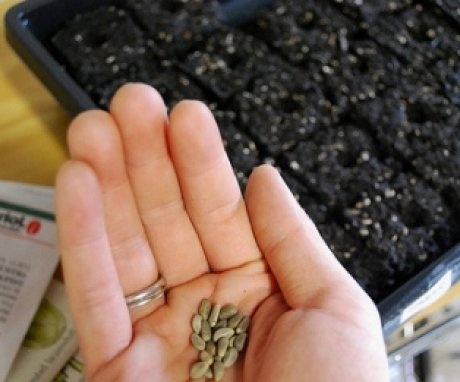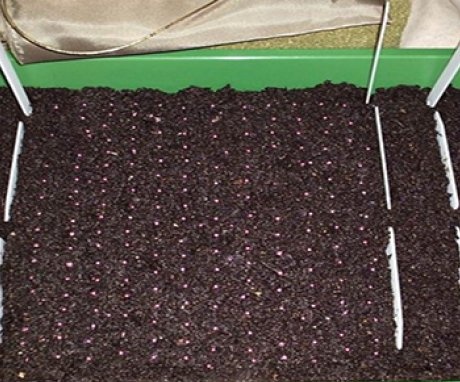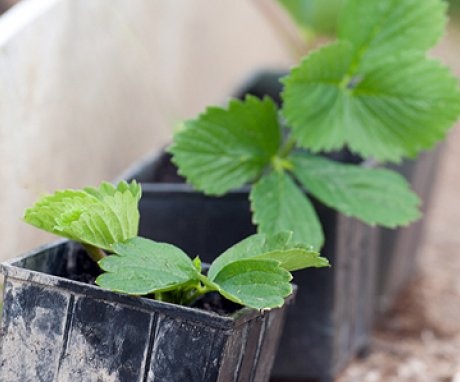When and how to properly plant strawberries with seeds
It is difficult to find a garden area that would not grow Strawberry... And, of course, I want the berries to be large, tasty and beautiful. An important role in the cultivation of plants is played by planting material, which is used for reproduction. Gardeners most often use the vegetative method of propagation of strawberries, but the method of propagation by seeds, although rather troublesome, has its own rather significant advantages.
Content:
- Preparation and correct timing of planting seeds
- Planting seeds
- Sowing seeds in peat tablets
- Strawberry seedling care
- Benefits of growing strawberry seeds
Preparation and correct timing of planting seeds
Pick ripe berries from strong, good bushes that produce good harvest... Seeds are best taken at the base of the berry or from its middle part, since it is in these parts of the fruit that the seeds are large and germinate well. Strawberries that grow from such seed, has a high yield. Separate the layer of berry pulp with seeds, lay out on a paper towel and dry. Gently wipe the dried mass with your palms, freeing the seeds. They are best stored in a glass jar.
Seeds do not lose germination properties for 4 years.
You can buy seeds in the store, but seeds of elite varieties are sold, as a rule, in very small quantities (3-5 pieces) in one bag. But you will know for sure strawberries what kind you grow. Soak the seeds two days before planting by placing them on a damp gauze or cloth. The water should not completely cover the seeds. After two days, when the seeds are swollen, they can be planted in the ground.
To make the strawberry more resistant to temperature changes, and the seeds germinate faster, three months before sowing, you can carry out the procedure stratification (hardening):
- Place the seeds in a small container.
- Moisten them with water.
- Place the moistened seeds in the refrigerator or any cool place with a temperature of +2 - +4 degrees.
- Make sure that the seeds do not dry out.
- Dry the seeds a little just before planting.
- The seeds are stratified within 14 days.
If you want to get a harvest of berries in the first year, then the best time to plant is January - February. Strawberries sown in May-June will only yield in the second year.
Planting seeds
At the bottom of the planting container, put a layer of expanded clay 1-2 cm for drainage, pour on top and compact the soil. Make grooves half a centimeter deep and pour water over them. Sow the seeds at a distance of two centimeters from each other, cover them with soil with a layer of no more than one centimeter. You do not need to sprinkle it with soil, but slightly press the seeds into the soil.
To prepare the soil, take in equal parts:
- Peat
- Humus
- Sand
- Chernozem
Another option for soil preparation:
- Sod - 2 parts
- Peat - 1 part
- Sand - part 1
It is advisable to add a complex mineral fertilizer (or rotted manure) and wood ash. For prevention pests, the larvae of which may be in the soil, seeds weeds, pathogens, ignite the soil in the oven or steam it over a saucepan of boiling water for 20-30 minutes.
This must be done at least three weeks before planting, during which time the soil will restore its microbiological properties.
You can try to make a landing "in the snow":
- Lay a layer of snow about a centimeter high on top of the ground
- Lay the seeds on the snow
- Let the snow melt
It is not necessary to cover the seeds with earth; with the melted snow, they themselves will go deep into the soil. Planting "in the snow" promotes more even germination of seeds. Cover the container with polyethylene. Place the resulting greenhouse next to the window so that sunlight falls on it. The first shoots appear in 25-30 days, even possibly in 40 days.
Sowing seeds in peat tablets
After stratification, place the container with seeds strawberries in a room where the temperature is maintained at 20 degrees, until germination. The seeds need to be constantly moistened.
Peat tablets fill with water and leave to swell. Place them in a plastic box or pallet. In the tablets, make a depression and place one germinated seed at a time, gently pressing into the peat. Cover the top with plastic and place in a warm, bright place. Water as needed, keeping the tablet peat from drying out.
After the appearance of the first 2-3 leaves, carry out pick seedlings.
Seedlings should be transplanted into separate small pots about 9 cm in diameter or into larger boxes at least 8 cm apart. Be sure to put expanded clay at the bottom of the pots for drainage. Make small depressions in the soil, pour water into it and carefully place the sprout there so that the leaves are on the surface.
The best thing seedlings plant in peat pots, with which it will be easy to transplant it to a garden bed in a permanent place. Water the transplanted seedlings gently with a stream of water under low pressure.
Strawberry seedling care
How to properly grow good strawberry seedlings:
- Strawberries are very fond of warmth, moisture and light. It is important that the soil in the seedling containers is always moist. Seedling should be in a warm (20-25 degrees) and bright room.
- You need to water the seedlings either through a pallet or by spraying from a spray bottle.
- Condensation formed on the film and leaves must be removed in order to avoid rotting and fungal diseases. You can make small holes in the film for ventilation.
- After the appearance of the second pair of leaves, remove the film. This should be done not immediately at one moment, but gradually accustoming the seedlings to fresh air. First, remove the film for an hour, and every day increase the time the plants are outside the greenhouse. Also, gently habituate your seedlings to sunlight.
- When 5 leaves are formed on the seedlings (around the end of May), the plants can be planted in the ground in the garden bed. Do not place the strawberries deep in the soil to avoid covering the apical bud. In this case, the plant may die. At the same time, make sure that the roots are not exposed during watering, which also adversely affects strawberries.
- If mold appears on the surface of the soil, carefully remove it, ventilate seedlings, dry and treat with an antifungal agent.
- Before planting on the garden bed, the seedlings are hardened by exposing them to fresh air in the shade. Thus, the strawberries gradually get used to the sun.
- It is recommended to remove the first strawberry flowers to allow the bushes to grow stronger and grow. In addition, this procedure allows you to increase yields, and strawberries endure the winter more easily. In the first year after sowing, remove all whiskers.
- When strawberry seedlings are grown outdoors in summer, they can be transplant until the end of August. If the seedlings are too small, you can dig the pots of plants into the beds until spring, in case of a snowless winter, cover them with spruce branches or covering material.
Benefits of growing strawberry seeds
The easiest way breeding strawberries - by means of a mustache with rosettes or dividing the bush into parts (if the strawberry is beardless). But these simple ways have drawbacks:
- Shoots can be infected with any disease.
- Strawberry, which has been propagated for a long time by the method of vegetation, gradually degenerates.
- The main advantage of growing strawberries from seeds is that they are not transmitted through the seeds. diseases.
Thus, when planting seeds, you will be sure that the plant is not sick with anything. And one more important factor is the possibility of their long-term storage. Any variety of strawberries can be propagated by seeds, with the exception of hybrid ones. You can pick up seeds of different varieties of strawberries, and harvest berries throughout the summer.
More information can be found in the video.




